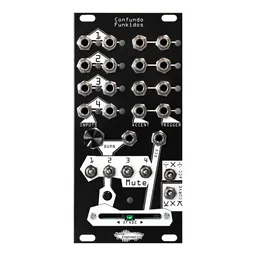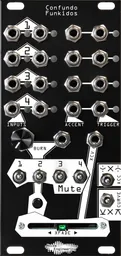A few weeks back, we released Confundo Funkidos, a rhythm crossfader and performance utility and successor to Confundo Funkitus. Funkitus was short lived and remained our most-asked-about legacy product, so we decided to bring it back, this time with a few fixes and features we wished we’d had on the original. New to Confundo Funkidos are a set of generatively controlled accent outputs that can liven up any drum patch. Today, we’ll explore a variety of ways of patching them with any percussive modules.
Prerequisite: what do these outputs do?
The Accent outputs on Confundo Funkidos are gate outputs that are designed to be used to dynamically enhance a drum sequence. They go high or low slightly before the trigger output fires, which allows them to be used as a modulation source without latency issues, and only change state when a trigger fires.
That means that if, for example, you’re using an accent output to modulate a VCA, the level of your VCA will never change in the middle of a kick tail, and the VCA will be modulated to the correct level just before the next kick hit, so you won’t have any sort of audible artifacts.
The accent patterns are derived in one of three ways from the trigger patterns at the inputs; you can learn more about how they’re generated by reading the user manual. They’re not random (unless you engage some probability with BURN or the crossfader), so if you have a repeating trigger sequence you’ll get a repeating Accent pattern, too.
All in all, the Accent gate outs are designed to work seamlessly with zero unwanted artifacts. So, let’s get creative and explore a few patches.
Easy mode: accent inputs
Many percussion modules have accent inputs built in, and this was the original inspiration for the Accent outputs on Confundo Funkidos. If you have, for example, some TipTop, Hexinverter, WMD, or Erica Synths drum modules in your system, you can simply patch the trigger output and accent output from Confundo Funkidos to the respective trigger input and accent input on your drum modules. The Accent outs have a high value above +5V, so they should trigger the accented state of almost any percussion module, and, thanks to the nifty timing mechanic we talked about above, should work patch seamlessly with no artifacts.

If you have a module like the BIA that doesn’t have a dedicated accent input, or you’ve patched a drum voice from scratch, there are a whole bunch of other things we can do with these outputs to liven up a patch.
Dynamics
One of my favorite ways to patch the Accent outs is to add some dynamics to various drum sounds. This is a technique used to great effect in many drum machines like the TR-909, and is a fantastic way to add some life to a drum loop.
Run your drum voice through a VCA, and offset the level of the VCA so that the drum can be heard, but is at a quieter level. Then, patch an Accent output from Confundo Funkidos to the CV input of your VCA. Unaccented notes will be quieter than accented ones, and you can increase the dynamic difference by turning the VCA’s offset up or down.
If you have a Xer Mixa, it’s particularly easy to add accent dynamics to any channel using an Expando Expandi. I use Action: Scale and Param: Volume, with the Offset around 75 and Amount at 100. Then, patch the Accent from Confundo to the corresponding input jack. This behavior allows there to be a dynamic difference between accented and unaccented notes that scales with the channel’s fader position.
Timbre and decay
By far, my favorite way to patch the Confundo Funkidos’s accent outputs is with a drum voice like the BIA or Incus Iteritas Alia. There’s no dedicated accent input per se, but all parameters are CV controllable, meaning that we can make accented notes behave however we want.
I like to run the Accent signal from Confundo Funkidos through a mult and into a number of attenuators – a module like our classic Sinc Defero does this perfectly – which allows me to dial in the amount of modulation that each parameter receives.
Subtlety is key here: I really like modulating the Decay and Fold parameters with accents, so that accented hits decay longer and sound brighter than unaccented ones. Generally, modulating a parameter less than 10% is more than enough to create contrast between hits. If I’m feeling particularly fancy, I’ll even combine this with the previous dynamic technique so that accented hits are louder, brighter, and longer than unaccented ones.




